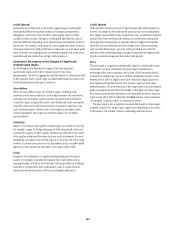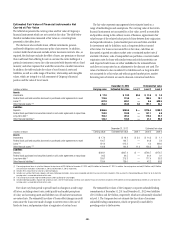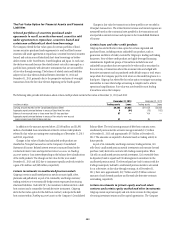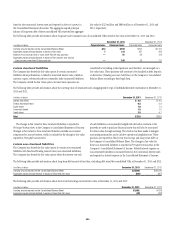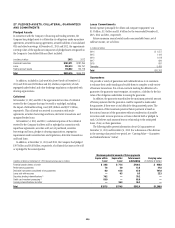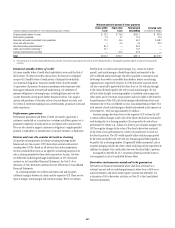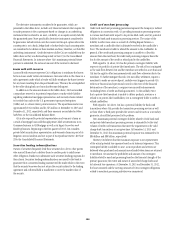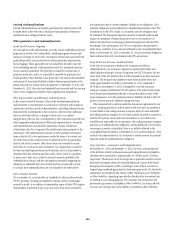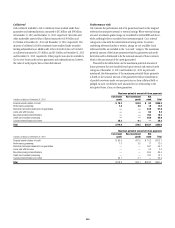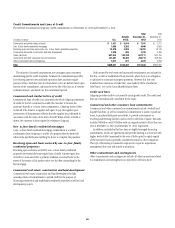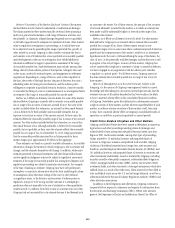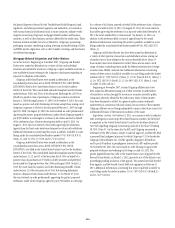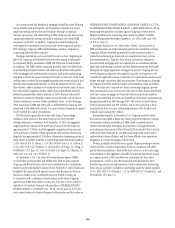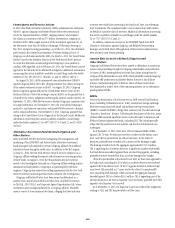Citibank 2013 Annual Report Download - page 315
Download and view the complete annual report
Please find page 315 of the 2013 Citibank annual report below. You can navigate through the pages in the report by either clicking on the pages listed below, or by using the keyword search tool below to find specific information within the annual report.
297
Maximum potential amount of future payments
In billions of dollars at December 31, 2012 except carrying value in millions
Expire within
1 year
Expire after
1 year
Total amount
outstanding
Carrying value
(in millions of dollars)
Financial standby letters of credit $ 22.3 $ 79.8 $102.1 $ 432.8
Performance guarantees 7.3 4.7 12.0 41.6
Derivative instruments considered to be guarantees 11.2 45.5 56.7 2,648.7
Loans sold with recourse — 0.5 0.5 87.0
Securities lending indemnifications (1) 80.4 — 80.4 —
Credit card merchant processing (1) 79.7 — 79.7 —
Custody indemnifications and other — 30.2 30.2 —
Total $200.9 $160.7 $361.6 $3,210.1
(1) The carrying values of securities lending indemnifications and credit card merchant processing were not material for either period presented, as the probability of potential liabilities arising from these guarantees
is minimal.
Financial standby letters of credit
Citi issues standby letters of credit which substitute its own credit for that of
the borrower. If a letter of credit is drawn down, the borrower is obligated
to repay Citi. Standby letters of credit protect a third party from defaults
on contractual obligations. Financial standby letters of credit include:
(i) guarantees of payment of insurance premiums and reinsurance risks
that support industrial revenue bond underwriting; (ii) settlement of
payment obligations to clearing houses, including futures and over-the-
counter derivatives clearing (see further discussion below); (iii) support
options and purchases of securities in lieu of escrow deposit accounts; and
(iv) letters of credit that backstop loans, credit facilities, promissory notes and
trade acceptances.
Performance guarantees
Performance guarantees and letters of credit are issued to guarantee a
customer’s tender bid on a construction or systems-installation project or to
guarantee completion of such projects in accordance with contract terms.
They are also issued to support a customer’s obligation to supply specified
products, commodities, or maintenance or warranty services to a third party.
Futures and over-the-counter derivatives clearing
Citi provides clearing services for clients executing exchange traded
futures and over-the-counter (OTC) derivatives contracts with central
counterparties (CCPs). Based on all relevant facts and circumstances,
Citi has concluded that it acts as an agent for accounting purposes in its
role as clearing member for these client transactions. As such, Citi does
not reflect the underlying exchange traded futures or OTC derivatives
contracts in its Consolidated Financial Statements. See Note 23 for a
discussion of Citi’s derivatives activities that are reflected in its Consolidated
Financial Statements.
As a clearing member, Citi collects and remits cash and securities
collateral (margin) between its clients and the respective CCP. There are two
types of margin: initial margin and variation margin. Where Citi obtains
benefits from or controls cash initial margin (e.g., retains an interest
spread), cash initial margin collected from clients and remitted to the
CCP is reflected within Brokerage Payables (payables to customers) and
Brokerage Receivables (receivables from brokers, dealers and clearing
organizations), respectively. However, for OTC derivatives contracts where
Citi has contractually agreed with the client that (a) Citi will pass through
to the client all interest paid by the CCP on cash initial margin; (b) Citi
will not utilize its right as clearing member to transform cash margin into
other assets; and (c) Citi does not guarantee and is not liable to the client for
the performance of the CCP, cash initial margin collected from clients and
remitted to the CCP is not reflected on Citi’s Consolidated Balance Sheet. The
total amount of cash initial margin collected and remitted in this manner as
of December 31, 2013 was approximately $1.4 billion.
Variation margin due from clients to the respective CCP, or from the CCP
to clients, reflects changes in the value of the client’s derivatives contracts for
each trading day. As a clearing member, Citi is exposed to the risk of non-
performance by clients (e.g., failure of a client to post variation margin to the
CCP for negative changes in the value of the client’s derivatives contracts).
In the event of non-performance by a client, Citi would move to close out
the client’s positions. The CCP would typically utilize initial margin posted
by the client and held by the CCP, with any remaining shortfalls required to
be paid by Citi as clearing member. Citi generally holds incremental cash or
securities margin posted by the client, which would typically be expected to be
sufficient to mitigate Citi’s credit risk in the event the client fails to perform.
As required by ASC 860-30-25-5, securities collateral posted by clients is
not recognized on Citi’s Consolidated Balance Sheet.
Derivative instruments considered to be guarantees
Derivatives are financial instruments whose cash flows are based on a
notional amount and an underlying instrument, where there is little or no
initial investment, and whose terms require or permit net settlement. For
a discussion of Citi’s derivatives activities, see Note 23 to the Consolidated
Financial Statements.



